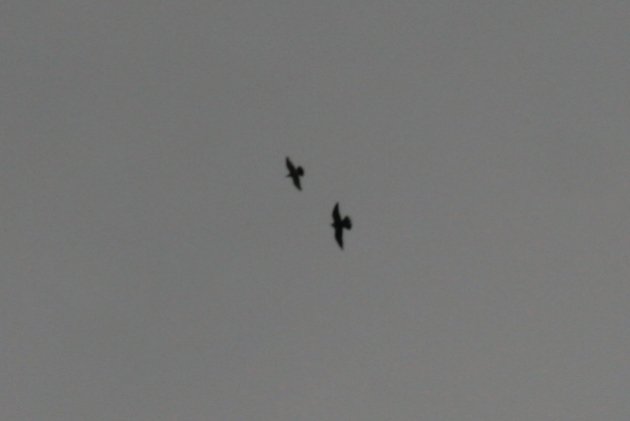
I’ve just seen something that was a) exciting for the birder in me to watch and that b) completely stumped the zoologist in me:
The ultimate altruistic birds.
Looking out of my office window I spotted a flock of around 35 Domestic Pigeons high up in the sky in a dense formation dashing from one side to the other. Clearly the flock was being attacked by one of the local Peregrine Falcons, which is a common occurrence but it usually happens so high up in the air that I scarcely get to notice it.
Scanning the sky carefully, I was able to spot the main flock of around 35 pigeons, a second small group of 5 birds that had broken away, and eventually the singled-out pigeon that was being pursued by the falcon (seen in the image above). So far, so good, so standard. But then something unexpected happened: the big flock had moved away, each bird in it probably happy that it wasn’t the “chosen one” of the falcon. The poor lunch-to-be, on the other hand, was frantically dashing across the sky, with the falcon only a few metres behind it in active flight, too busy watching the falcon’s movements to really have a plan or idea where it was going. And the small group of five? Now, that was the interesting part.
I would have expected this group to also get away from the falcon as quickly as possible, as the big flock had done. But, oh no: on the contrary! These five birds formed a dense cloud and actively followed the falcon-pigeon pair. I was clearly able to see that they deliberately got between the hunted pigeon and the falcon, trying to incorporate the singled-out bird into their group on no less than four occasions! This was very risky for them as each bird within the group – having already been safe from the falcon – exposed itself again and again and again to a high probability of death in case it would become the next one singled out instead of the bird that had been pursued by the falcon before.
This is clearly the most altruistic behaviour I have ever seen, and I fail to explain it. This is beyond a parent bird trying to lure a predator away from the nest, or a group of buffalos driving off a pack of lions from a calf. There was no way these pigeons would have driven off the falcon, or had a more than average chance of getting away from the predator as is the case with the parent at the nest. These five birds chose to expose themselves to a very high risk of dying – for the sake of another bird.
Have you seen anything like this before? Or do you have an explanation?
Oh, by the way: all pigeons got away, and the falcon remained hungry.
.













We’ve all seen prey species mob a predator and maybe that is what the five pigeons were intending to do and it just looked like they were trying to incorporate the solo bird into the flock?
Though, I have to say, when the pigeons in my neighborhood spot a falcon they all take off and it is every pigeon for itself!
I think it is based on reciprocity. Rock pigeons are sedentary and their flocks have stable compositions of individuals. Perhaps the group of 5 was trying to help their flockmate knowing the favor would be reciprocated if one of them became a target. I have often seen seemingly altruistic behavior in feeding flocks of pigeons. One bird would stand guard and watch for danger, denying itself food, while the rest pecked away. Different birds would take turns being the sentinel. I don’t think a bird would forgo an opportunity to feed or put itself at risk of being captured by a predator if it didn’t expect to benefit in the future from those it was helping.